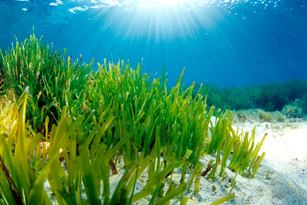In the Mediterranean Sea, the perennial Neptune grass (Posidonia oceanica) forms meadows that cover about 15,000 square miles of rocks and sand and is a key part of the marine ecosystem. About 30 percent of the bacteria found in Neptune grass is composed of Marinomonas strains, which include M. posidonica, considered to be the most abundant Marinomonas species, and M. mediterranea, the only species in the genus that has melanins.

P. oceanica meadows such as this one off Formentera Island, Spain
play host to Marinomonas bacteria. Photo by Manu Sanfelix
M. mediterranea has enzymes that can break down compounds in industrial and oil refinery emissions. The bacterial enzymes might also be useful in breaking down lignocellulosic material in sea grass, and thus might have potential applications in commercial biofuel production.
The genomes of both Marinomonas mediterranea and Marinomonas posidonica will be sequenced and researchers intend to compare the data with a third Marinomonas genome previously sequenced at the DOE JGI. The latter bacteria was isolated from a salt marsh grass off the British coast and has been found to break down a compound which releases dimethyl sulfide (DMS), which affects both the global sulfur and carbon cycles. An estimated 35 million tons of DMS are released annually and is responsible for much of the cloud cover over the oceans, affecting the climate in these regions.
Principal Investigators: Antonio Sanchez Amat, University of Murcia
Program: CSP 2010